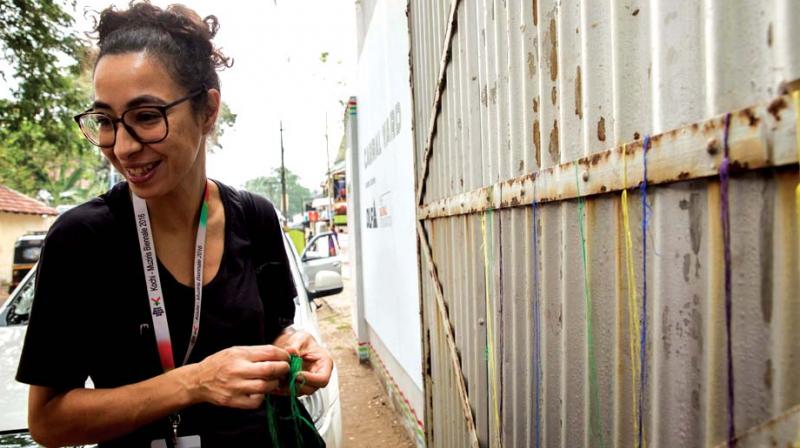Threads' trail through spaces in memory

Amidst the scramble to experience the variety of artistic production on display at the third edition of the Kochi-Muziris Biennale (KMB), chances are Latifa Echakhch’s works have fallen by the wayside. The Moroccan-born artist would have it no other way.
Tracing a breadcrumb trail of her movements around Fort Kochi thorough pieces of coloured satin strings, Echakhch wants people “to encounter them by accident and wonder what they are?” In so doing, they would have walked not just in her footsteps, but waded into a memory.
“When I was a kid in Morocco, I saw in some poor neighbourhoods colour threads attached to the fences and window grills of homes. I had always wondered about them.
Then one day I saw kids working with 10 metre satin sheets stretched from these windows. The lengths they cut were sold at embroidery shops, while the remaining pieces were left behind,” Echakhch said.
Likening these forgotten strings to an architectural embellishment, she went around tying them to gates, doors, windows and other design elements – “anywhere it was possible” – at Biennale venues. The installation, titled ‘Kmiss’ – a play on the Arabic name for a “beautifully embroidered dress”, was not intended to be a performance, but it quickly became one.
“I was not supposed to perform it and I was mostly discreet, but some people saw me doing it. There were a lot of questions, but it was quite nice. Most people thought that I had a spiritual practice with this work like making wishes. That made me wonder if there could be as much of a mystical element to the work as there is a social message,” she said.
Echakhch envisioned the installation as a work that dealt with tradition and also highlighted the “heaviness” of poverty, its effect on society and the need for money. “The embroidery in a Kmiss is so beautiful and precious. I like thinking that the dress came from the streets. It draws a balance between this beauty and poverty,” she said.
But beyond the drive to make money, Kmiss is also about the child-like joy of finding something new. “It has to be discovered, but it is not a map or treasure hunt. I imagine a group of kids following my path. I like having this strangeness and mystery about the artwork,” she said.
That was part of the reason for the attempt to keep the act of tying of the threads hidden from public view. Echakhch’s practice involves leaving objects or installations like a still life with no indication to people that it is separate from the rest of the surroundings.

